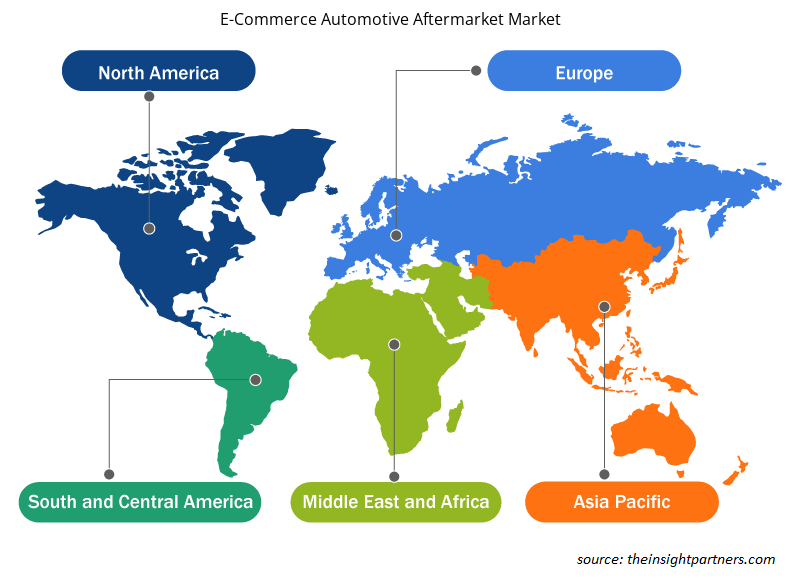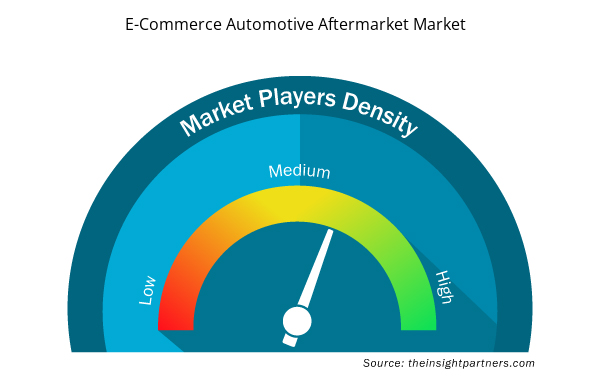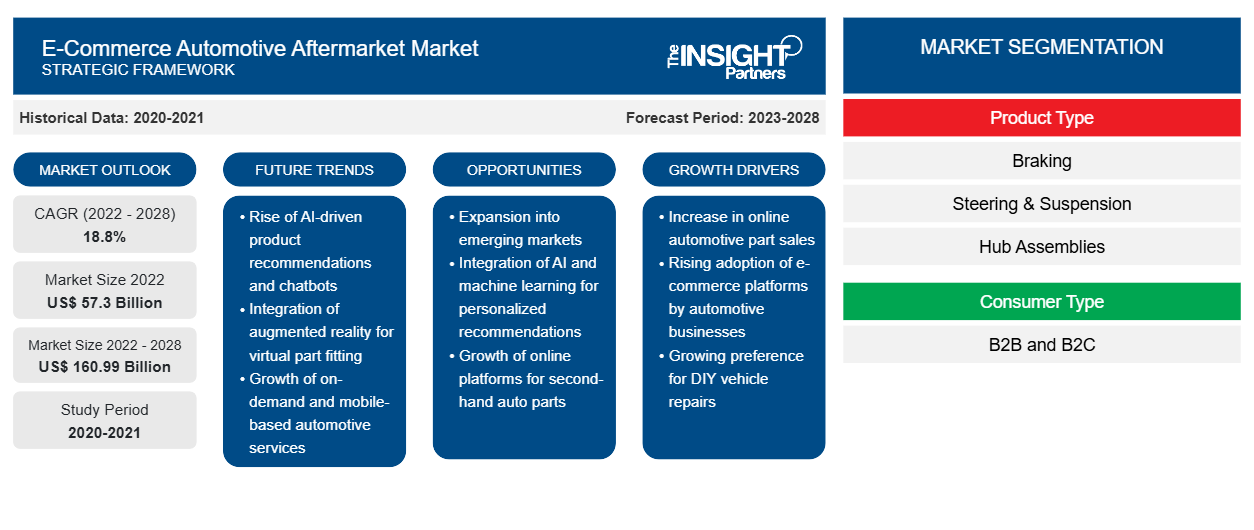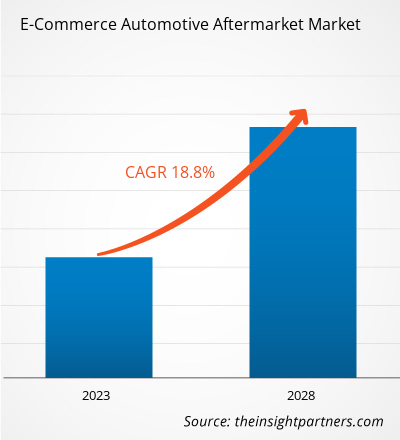من المتوقع أن ينمو سوق قطع غيار السيارات عبر التجارة الإلكترونية من 57،301.1 مليون دولار أمريكي في عام 2022 إلى 1،60،985.4 مليون دولار أمريكي بحلول عام 2028. ومن المتوقع أن ينمو بمعدل نمو سنوي مركب قدره 18.8٪ من عام 2022 إلى عام 2028.
تتمتع أمريكا الشمالية بصناعة سيارات متطورة بسبب الإنتاج المستمر للمركبات التجارية. وفقًا لتقرير المنظمة الدولية لصانعي السيارات ( OICA ) لعام 2021، أنتجت الولايات المتحدة 7،604،154 مركبة تجارية في عام 2021، و6،895،604 في عام 2020، و8،367،239 في عام 2019. وبالمثل، أنتجت كندا 826،767 مركبة تجارية في عام 2021، و1،048،942 في عام 2020، و1،455،215 في عام 2019، وفقًا لتقرير OICA لعام 2021. أنتجت المكسيك ما مجموعه 2،437،411 مركبة تجارية في عام 2021، و2،209،121 في عام 2020، و2،604،080 في عام 2019، وفقًا لنفس التقرير. وفقًا لإحصائيات OICA، تحتل الولايات المتحدة وكندا والمكسيك الصدارة في قطاع إنتاج المركبات التجارية على مستوى العالم . وبالتالي، فإن الإنتاج المستمر للمركبات التجارية في جميع أنحاء المنطقة يدعم نمو سوق ما بعد البيع للسيارات عبر التجارة الإلكترونية في أمريكا الشمالية.
تأثير جائحة كوفيد-19 على سوق قطع غيار السيارات عبر التجارة الإلكترونية
في أمريكا الشمالية، شهدت الولايات المتحدة وكندا والمكسيك ارتفاعًا كبيرًا في عدد حالات الإصابة بكوفيد-19. تم إغلاق العديد من مصانع التصنيع، وكانت البلديات تعمل بوتيرة أبطأ، وتوقفت عمليات صناعات السيارات وأشباه الموصلات في عام 2020، بعد ظهور جائحة كوفيد-19. في المنطقة، كان لانقطاع سلسلة القيمة الناجم عن إغلاق العديد من مرافق الإنتاج والمستودعات في الولايات المتحدة وكندا بسبب جائحة كوفيد-19 تأثير فوري على الطلب قصير الأجل والبنية التحتية اللوجستية ومخزونات المنتجات. ومع ذلك، استمرت صناعة السيارات في النمو بسبب الخدمات الفريدة التي تقدمها القنوات عبر الإنترنت من حيث الخدمة والإصلاح والاستبدال. قبل ظهور جائحة كوفيد-19، كان التجارة الإلكترونية تتوسع بسرعة. ومع ذلك، أدى الوباء إلى زيادة عدد المستهلكين الأمريكيين الذين يستخدمون المنصات عبر الإنترنت، مما شجعهم على إنفاق المزيد من المال. وقد أدت هذه الأنشطة إلى تحقيق حصة كبيرة من الإيرادات بسبب انتشار نظام بيئي للتجارة الإلكترونية منظم جيدًا يسمح لصانعي معدات السيارات بالانخراط في مبيعات ما بعد البيع الخاصة بالتجارة الإلكترونية. وفي أبريل 2021، زادت مبيعات مكونات السيارات وأجزائها وإكسسواراتها في سوق ما بعد البيع للسيارات عبر التجارة الإلكترونية في الولايات المتحدة وكندا بأكثر من 60% مقارنة بعام 2020.
قم بتخصيص هذا التقرير ليناسب متطلباتك
ستحصل على تخصيص لأي تقرير - مجانًا - بما في ذلك أجزاء من هذا التقرير، أو تحليل على مستوى الدولة، وحزمة بيانات Excel، بالإضافة إلى الاستفادة من العروض والخصومات الرائعة للشركات الناشئة والجامعات
- احصل على أهم اتجاهات السوق الرئيسية لهذا التقرير.ستتضمن هذه العينة المجانية تحليلاً للبيانات، بدءًا من اتجاهات السوق وحتى التقديرات والتوقعات.
رؤى حول سوق قطع غيار السيارات للتجارة الإلكترونية
ارتفاع في عدد مستهلكي DIY و DIFM
تقدم أمازون وإيباي خدمة شحن قطع غيار السيارات في نفس اليوم في العديد من المواقع. ولديهما علاقات تجارية مع عدد قليل من مصنعي الأجزاء الرئيسيين، مثل Robert Bosch GmbH و Denso Corp. و Magna International Inc. وContinental AG و ZF Friedrichshafen AG التي تقدم خدمات التثبيت. يعرف موردو قطع غيار السيارات التقليديون أن العملاء، الذين يشترون مكونات قطع غيار السيارات لأسباب تتعلق بالصيانة الذاتية، سيكونون أول شريحة تنتقل إلى مواقع التجارة الإلكترونية الرقمية بدلاً من موردي قطع غيار السيارات التقليديين. لذا فإن الحفاظ على عمل ثابت مع التجار والفنيين التجاريين يعد استراتيجية فريدة للبقاء في المنافسة. تشمل الميزات القياسية لأحدث السيارات أجهزة استشعار للكشف عن تغييرات المسار وكاميرات 360 درجة وتكنولوجيا تتطلب مساعدة الخبراء.
في اتجاه "افعل ذلك من أجلي" ( DIFM )، من المتوقع أن يعتمد المستهلكون الذين يمتلكون سيارات متقدمة على شركات إصلاح السيارات والميكانيكا. على سبيل المثال، تستخدم شركة Advance Auto Parts التجارة الإلكترونية لاستهداف مجموعات السوق هذه بشكل فريد من خلال تزويدهم بميزات في تكنولوجيا مساعدة السائق. يجب أن يستمر سوق قطع غيار السيارات للتجارة الإلكترونية في استغلال أسواق B2C (من شركة إلى مستهلك) وB2B (من شركة إلى شركة) الرقمية وسلاسل التوريد المتنامية التي تدعم هذه الأسواق حيث يواصل المنافسون متابعة سوق قطع غيار السيارات للتجارة الإلكترونية المربحة هذه. ونتيجة لذلك، من المتوقع أن يخلق العدد المتزايد من العملاء الذين يتبنون الشراء عبر الإنترنت لمكونات السيارات في قطاع السيارات للتجارة الإلكترونية فرصًا جديدة في سوق قطع غيار السيارات للتجارة الإلكترونية.
رؤى السوق بناءً على نوع المنتج
بناءً على نوع المنتج، يتم تقسيم سوق ما بعد البيع للسيارات عبر التجارة الإلكترونية إلى الفرامل (وسادات الفرامل، والهيدروليكا والأجهزة، والدوار والأسطوانة)، والتوجيه والتعليق (المفاصل الكروية، وقضبان التعادل، وروابط قضيب التوازن، والمحامل/الأختام، وغيرها)، وتجميعات المحور، والمفاصل العالمية، والحشيات، والمرشحات، وشمعات الإشعال، وغيرها. في عام 2021، قادت شريحة أخرى سوق ما بعد البيع للسيارات عبر التجارة الإلكترونية، حيث استحوذت على أكبر حصة في السوق.
رؤى السوق المستندة إلى نوع المستهلك
بناءً على نوع المستهلك، يتم تقسيم سوق ما بعد البيع للسيارات عبر التجارة الإلكترونية إلى B2B وB2C. في عام 2021، قاد قطاع B2C سوق ما بعد البيع للسيارات عبر التجارة الإلكترونية، حيث استحوذ على حصة سوقية أكبر.
يتبنى اللاعبون في السوق استراتيجيات، مثل عمليات الدمج والاستحواذ والمبادرات السوقية، للحفاظ على مواقعهم في سوق ما بعد البيع للسيارات عبر التجارة الإلكترونية. وفيما يلي قائمة ببعض التطورات التي قام بها اللاعبون الرئيسيون:
- في مارس 2022، فازت شركة DENSO Aftermarket، الشركة التابعة لشركة DENSO، الشركة الرائدة في تصنيع مكونات المعدات الأصلية (OE)، بجائزة المورد للعام 2021، التي تمنحها GroupAuto International، وهي منظمة شراء عالمية رائدة.
- في سبتمبر 2020، أتمت شركة LKQ Corporation الصفقة المعلنة مسبقًا لبيع حصصها في شركتين لتجارة الجملة لقطع غيار السيارات في جمهورية التشيك إلى شركة Swiss Automotive Group AG. ولم يتم الكشف عن شروط الصفقة.
نطاق تقرير ما بعد البيع للسيارات للتجارة الإلكترونية
رؤى إقليمية حول سوق قطع غيار السيارات للتجارة الإلكترونية
قام المحللون في Insight Partners بشرح الاتجاهات والعوامل الإقليمية المؤثرة على سوق ما بعد البيع للسيارات عبر التجارة الإلكترونية طوال فترة التوقعات بشكل شامل. يناقش هذا القسم أيضًا قطاعات سوق ما بعد البيع للسيارات عبر التجارة الإلكترونية والجغرافيا في جميع أنحاء أمريكا الشمالية وأوروبا ومنطقة آسيا والمحيط الهادئ والشرق الأوسط وأفريقيا وأمريكا الجنوبية والوسطى.

- احصل على البيانات الإقليمية المحددة لسوق قطع غيار السيارات الإلكترونية
نطاق تقرير سوق قطع غيار السيارات للتجارة الإلكترونية
| سمة التقرير | تفاصيل |
|---|---|
| حجم السوق في عام 2022 | 57.3 مليار دولار أمريكي |
| حجم السوق بحلول عام 2028 | 160.99 مليار دولار أمريكي |
| معدل النمو السنوي المركب العالمي (2022 - 2028) | 18.8% |
| البيانات التاريخية | 2020-2021 |
| فترة التنبؤ | 2023-2028 |
| القطاعات المغطاة | حسب نوع المنتج
|
| المناطق والدول المغطاة | أمريكا الشمالية
|
| قادة السوق وملفات تعريف الشركات الرئيسية |
|
كثافة اللاعبين في السوق: فهم تأثيرها على ديناميكيات الأعمال
يشهد سوق قطع غيار السيارات عبر التجارة الإلكترونية نموًا سريعًا، مدفوعًا بالطلب المتزايد من المستخدم النهائي بسبب عوامل مثل تفضيلات المستهلكين المتطورة والتقدم التكنولوجي والوعي المتزايد بفوائد المنتج. ومع ارتفاع الطلب، تعمل الشركات على توسيع عروضها والابتكار لتلبية احتياجات المستهلكين والاستفادة من الاتجاهات الناشئة، مما يؤدي إلى زيادة نمو السوق.
تشير كثافة اللاعبين في السوق إلى توزيع الشركات أو المؤسسات العاملة في سوق أو صناعة معينة. وهي تشير إلى عدد المنافسين (اللاعبين في السوق) الموجودين في مساحة سوق معينة نسبة إلى حجمها أو قيمتها السوقية الإجمالية.
الشركات الرئيسية العاملة في سوق قطع غيار السيارات الإلكترونية هي:
- مجموعة علي بابا القابضة المحدودة
- أمازون.كوم، المحدودة.
- أوتوزون، المحدودة
- شوبي365
- كاتي سبا
إخلاء المسؤولية : الشركات المذكورة أعلاه ليست مرتبة بأي ترتيب معين.

- احصل على نظرة عامة على أهم اللاعبين الرئيسيين في سوق قطع غيار السيارات للتجارة الإلكترونية
نبذة عن الشركة
تعد شركة Alibaba Group Holding Limited؛ وAmazon.com، Inc.؛ وAutoZone، Inc.؛ وShopee365؛ وCATI SpA؛ وeBay Inc.؛ وLKQ Corporation؛ وThe Pep Boys؛ وCarParts.com، Inc؛ وDenso Corporation من اللاعبين الرئيسيين الرائدين في السوق.
- التحليل التاريخي (سنتان)، السنة الأساسية، التوقعات (7 سنوات) مع معدل النمو السنوي المركب
- تحليل PEST و SWOT
- حجم السوق والقيمة / الحجم - عالميًا وإقليميًا وقطريًا
- الصناعة والمنافسة
- مجموعة بيانات Excel



Report Coverage
Revenue forecast, Company Analysis, Industry landscape, Growth factors, and Trends

Segment Covered
This text is related
to segments covered.

Regional Scope
North America, Europe, Asia Pacific, Middle East & Africa, South & Central America

Country Scope
This text is related
to country scope.
الأسئلة الشائعة
Rising number of e-commerce providers and increased replacement rates boost B2C industry are driving the growth of the e-commerce automotive aftermarket market.
Increasing customer awareness for automotive aftermarket is presenting significant potential for the future growth of the e-commerce automotive aftermarket market players.
APAC is the fastest growing region in the global e-commerce automotive aftermarket market.
Based on product type, the e-commerce automotive aftermarket market is segmented into braking, steering and suspension, hub assemblies, universal joints, gaskets, filters, spark plug, and others. In 2021, the others segment led the e-commerce automotive aftermarket market, accounting for the largest share in the market.
The incremental growth of the e-commerce automotive aftermarket market during the forecast period of 2022-2028 is US$ 103,684.37 million.
The major five companies in the e-commerce automotive aftermarket market include Alibaba Group Holding Limited; Amazon.com, Inc.; AutoZone, Inc.; LKQ Corporation; and CarParts.com, Inc.
Trends and growth analysis reports related to Automotive and Transportation : READ MORE..
The List of Companies - E-Commerce Automotive Aftermarket Market
- Alibaba Group Holding Limited
- Amazon.com, Inc.
- AutoZone, Inc.
- Shopee365
- CATI S.p.A.
- eBay Inc.
- LKQ Corporation
- The Pep Boys
- CarParts.com, Inc
- Denso Corporation
The Insight Partners performs research in 4 major stages: Data Collection & Secondary Research, Primary Research, Data Analysis and Data Triangulation & Final Review.
- Data Collection and Secondary Research:
As a market research and consulting firm operating from a decade, we have published and advised several client across the globe. First step for any study will start with an assessment of currently available data and insights from existing reports. Further, historical and current market information is collected from Investor Presentations, Annual Reports, SEC Filings, etc., and other information related to company’s performance and market positioning are gathered from Paid Databases (Factiva, Hoovers, and Reuters) and various other publications available in public domain.
Several associations trade associates, technical forums, institutes, societies and organization are accessed to gain technical as well as market related insights through their publications such as research papers, blogs and press releases related to the studies are referred to get cues about the market. Further, white papers, journals, magazines, and other news articles published in last 3 years are scrutinized and analyzed to understand the current market trends.
- Primary Research:
The primarily interview analysis comprise of data obtained from industry participants interview and answers to survey questions gathered by in-house primary team.
For primary research, interviews are conducted with industry experts/CEOs/Marketing Managers/VPs/Subject Matter Experts from both demand and supply side to get a 360-degree view of the market. The primary team conducts several interviews based on the complexity of the markets to understand the various market trends and dynamics which makes research more credible and precise.
A typical research interview fulfils the following functions:
- Provides first-hand information on the market size, market trends, growth trends, competitive landscape, and outlook
- Validates and strengthens in-house secondary research findings
- Develops the analysis team’s expertise and market understanding
Primary research involves email interactions and telephone interviews for each market, category, segment, and sub-segment across geographies. The participants who typically take part in such a process include, but are not limited to:
- Industry participants: VPs, business development managers, market intelligence managers and national sales managers
- Outside experts: Valuation experts, research analysts and key opinion leaders specializing in the electronics and semiconductor industry.
Below is the breakup of our primary respondents by company, designation, and region:

Once we receive the confirmation from primary research sources or primary respondents, we finalize the base year market estimation and forecast the data as per the macroeconomic and microeconomic factors assessed during data collection.
- Data Analysis:
Once data is validated through both secondary as well as primary respondents, we finalize the market estimations by hypothesis formulation and factor analysis at regional and country level.
- Macro-Economic Factor Analysis:
We analyse macroeconomic indicators such the gross domestic product (GDP), increase in the demand for goods and services across industries, technological advancement, regional economic growth, governmental policies, the influence of COVID-19, PEST analysis, and other aspects. This analysis aids in setting benchmarks for various nations/regions and approximating market splits. Additionally, the general trend of the aforementioned components aid in determining the market's development possibilities.
- Country Level Data:
Various factors that are especially aligned to the country are taken into account to determine the market size for a certain area and country, including the presence of vendors, such as headquarters and offices, the country's GDP, demand patterns, and industry growth. To comprehend the market dynamics for the nation, a number of growth variables, inhibitors, application areas, and current market trends are researched. The aforementioned elements aid in determining the country's overall market's growth potential.
- Company Profile:
The “Table of Contents” is formulated by listing and analyzing more than 25 - 30 companies operating in the market ecosystem across geographies. However, we profile only 10 companies as a standard practice in our syndicate reports. These 10 companies comprise leading, emerging, and regional players. Nonetheless, our analysis is not restricted to the 10 listed companies, we also analyze other companies present in the market to develop a holistic view and understand the prevailing trends. The “Company Profiles” section in the report covers key facts, business description, products & services, financial information, SWOT analysis, and key developments. The financial information presented is extracted from the annual reports and official documents of the publicly listed companies. Upon collecting the information for the sections of respective companies, we verify them via various primary sources and then compile the data in respective company profiles. The company level information helps us in deriving the base number as well as in forecasting the market size.
- Developing Base Number:
Aggregation of sales statistics (2020-2022) and macro-economic factor, and other secondary and primary research insights are utilized to arrive at base number and related market shares for 2022. The data gaps are identified in this step and relevant market data is analyzed, collected from paid primary interviews or databases. On finalizing the base year market size, forecasts are developed on the basis of macro-economic, industry and market growth factors and company level analysis.
- Data Triangulation and Final Review:
The market findings and base year market size calculations are validated from supply as well as demand side. Demand side validations are based on macro-economic factor analysis and benchmarks for respective regions and countries. In case of supply side validations, revenues of major companies are estimated (in case not available) based on industry benchmark, approximate number of employees, product portfolio, and primary interviews revenues are gathered. Further revenue from target product/service segment is assessed to avoid overshooting of market statistics. In case of heavy deviations between supply and demand side values, all thes steps are repeated to achieve synchronization.
We follow an iterative model, wherein we share our research findings with Subject Matter Experts (SME’s) and Key Opinion Leaders (KOLs) until consensus view of the market is not formulated – this model negates any drastic deviation in the opinions of experts. Only validated and universally acceptable research findings are quoted in our reports.
We have important check points that we use to validate our research findings – which we call – data triangulation, where we validate the information, we generate from secondary sources with primary interviews and then we re-validate with our internal data bases and Subject matter experts. This comprehensive model enables us to deliver high quality, reliable data in shortest possible time.


 احصل على عينة مجانية لهذا التقرير
احصل على عينة مجانية لهذا التقرير